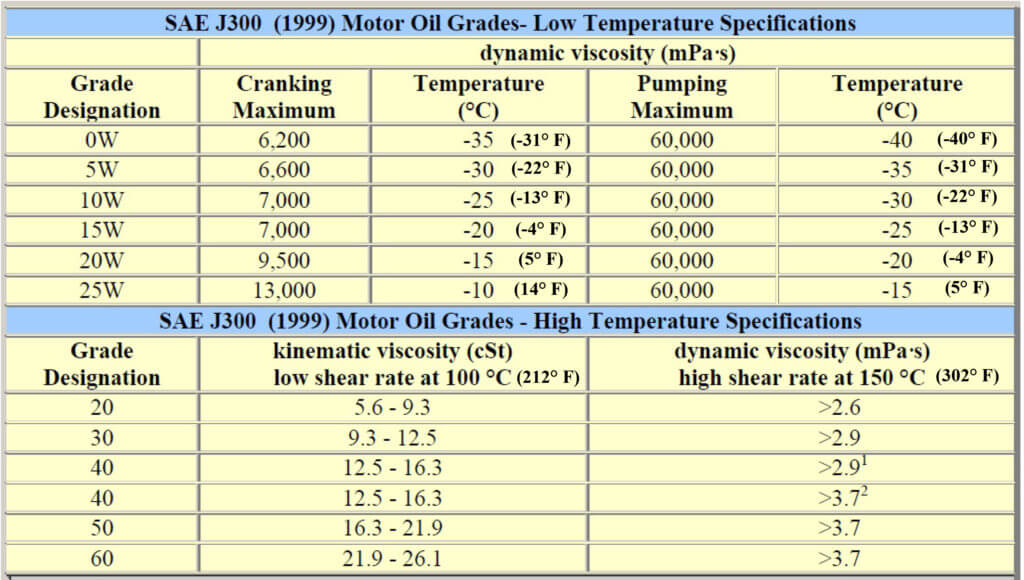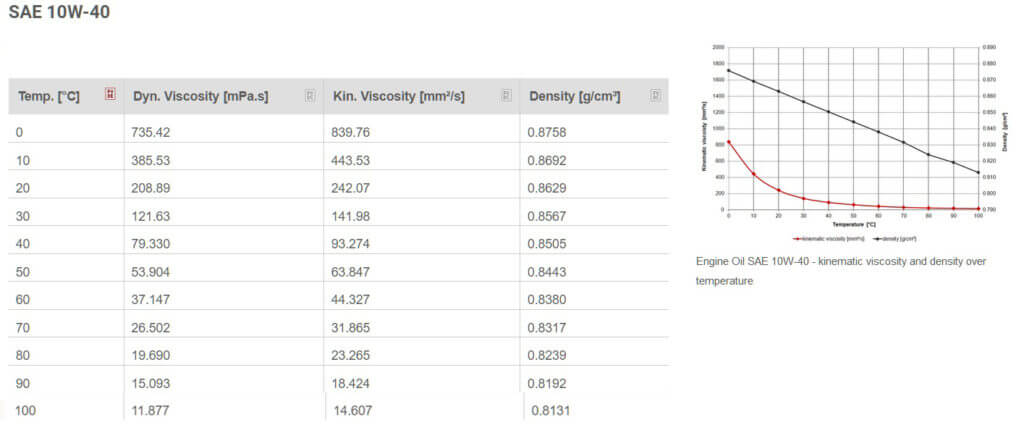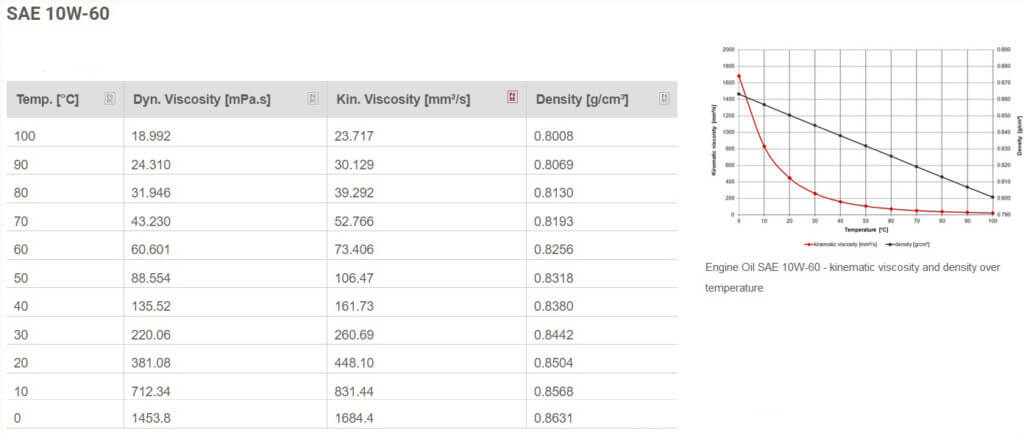Understanding Motor Oil Specifications
Making sense of motor oil specifications.
Understanding the role of motor oil
Motor oil reduces friction between surfaces
Reduces wear
Reduces heat between sliding parts
Reduces loss of energy
Acts like a coolant to remove heat from the friction area
Acts as a seal between the cylinder and the piston rings
What is motor oil viscosity?
Viscosity is a measurement that categorizes a liquid’s resistance to flow. However, since oil thins as it heats and thickens as it cools, the oil’s viscosity rating must include a temperature reference. There are also two types of oil viscosity measurements; Kinematic and Absolute (also called dynamic).
Motor oil’s kinematic viscosity is measured in centistokes (cST) or mm2/s. A centistoke is 1/100 of a stoke. A Stoke is a measurement determined by how much a certain mass (density) of liquid moves (in centimeters) during a period of time, based on grams per cubic centimeter through an orifice.
Here’s a simple example of Kinematic viscosity; drill a hole of a set size in a small cup and plug it. Then fill the cup with motor oil at 100° C (212°F). Unplug the hole and measure how many grams of oil flows through the hole during a set period of time. You now have a Kinematic rating. Unfortunately, engines don’t work that way. Measuring oil’s resistance to flow in an engine is far more complicated.
First, engines don’t rely on gravity to obtain flow; they circulate oil under pressure using an oil pump. Second, motor oil doesn’t just drip out of a hole in a cup. It must travel between bearings and rotating shafts and through narrow oil gallery passages. As the oil slides between bearings and shafts and through passages, it encounters drag.
Knowing that, let’s go back to our dripping cup example. Instead of leaving the top of the cup open to the atmosphere, we’ll cap it and apply 10-psi of pressure. Next, we’ll attach a 12″ drinking straw to the hole at the bottom of the cup. If we repeat the test at -17.7°C (0°F) we’ll get a completely different result and this result will be it’s absolute or dynamic viscosity.
In other words, motor oil’s absolute viscosity is a measure of how the oil acts when the engine is cranking and the oil is being pumped. A motor oil’s absolute/dynamic viscosity really tells you how the oil will behave at cold startup when you’re cranking and how well it pumps when cold.
How is motor oil viscosity expressed?
The Society of Automotive Engineers (SAE) uses a common classification of “XW-XX,” where the number preceding the “W” (winter) is the oil’s absolute/dynamic low-temperature (-17.7°C (0°F) performance and the other number represents the oil’s Kinematic high temperature at 100° C (212°F).
The Winter rating is calculated using a special testing apparatus called a cold-cranking simulator and each oil grade is measured in mPa’s. The oil’s high-temperature grade is measured in (cSt).
IMPORTANT NOTE: The oil grades shown below are tested at different temperatures! A 0W oil is tested at -35°C while the 5W oil is tested at -30°C. The viscosities of the W grades are MAXIMUM allowable, while the viscosities of the high temperature grades are MINIMUMS

So, a 5W-30 grade oil thickens less than a 10W-30 grade oil in cold weather. That means a 5W-30 oil will allow your engine to crank faster and the oil pump can pump it easier than a 10W-30 oil at the same cold temperature.
At higher temperatures, a 5W-30 grade thins out more quickly than a 5W-40 grade oil at the same high temperature.
Viscosity index (VI)
All oil thins as it warms up. The rate at which the oil thins is expressed by its viscosity index. If the oil has a very slow rate of thinning as temperature increases, then its VI is high. In other words, an oil with high VI maintains a more consistent viscosity over a wide temperature range.
The effect of temperature on oil viscosity is NOT uniform
Oil thinning or thickening is not linear. For example, an oil’s kinematic viscosity will change MORE between 50°F and 59°F that it will between 176°F and 185°F.
“The viscosity index (VI) for base stocks and lube oils was developed by Dean and Davis from Standard Oil in the year 1929. At this time, no multi-grade oils and no synthetic oils were available. For the VI scale, two limit points were set. Oils with low temperature-dependent viscosity change (HVI oils refined from Pennsylvania crudes, paraffinic oil) were on the high end of the scale.
Their VI was indicated with 100, which represented the best VI. Oils with significant viscosity change (LVI-oils, refined from Texas gulf crudes, naphthenic oil) represented the low end. Their VI was indicated with 0 – this was the worst possible VI. The VI values related to mineral oils. Lube oils were then compared to these benchmarks. If the oil was similar to the paraffinic oil, a VI of 100 was assigned; if it was similar to the naphthenic oil, a VI of 0 was assigned. In the middle, a VI of around 50 would be assigned. To increase the VI to values higher than 100, new base oil types and special additives were developed later on.” —Anton Paar
The VI of motor oil ranges from -60 to as much as 400, depending on the types of viscosity modifiers used by the refinery or oil blender. Typically, motor oil contains between 5% to 20% viscosity improver additives.
This is important. People often think that the first and second numbers are both kinematic values. They’re not. The number before the W is the oil’s absolute viscosity while cranking based on ASTM TEST D5293 cold-cranking simulator) and pumping viscosity based on ASTM D4684, ASTM D3829, ASTM D6821 or ASTM D6896 (mini rotary viscometer). The cold-cranking simulates the cold start of an engine at various temperatures based on the projected viscosity of the oil being tested. In other words, testers don’t use the same temperature for each oil.
For example, to achieve a 0W rating, the oil must not exceed a maximum of 6200 mPa (megapascal) cranking viscosity at -31°F (-35°C) and a maximum pumping viscosity of 60,000 mPa at -40° F/C.
See this chart to understand how two oils with the same first number can have two different absolute viscosities.

So a 5W oil will ALWAYS provide better cranking and pump ability than a 10W at ALL temperatures. Obviously, it’s more important to use a 0W or 5W oil in colder climates to help cranking and pump ability, but a 0W or 5W also helps cranking and pump ability in warmer temperatures as well.
Now let’s examine the differences in absolute/dynamic mPa of two oils with the same first number: 10W40 and 10W-60
The 10W-40 has a dynamic viscosity of 735.42 mPa @ 0°C. But the 10W-60 oil has a dynamic viscosity of 1453.82 mPa @ 0°C. Both oils are 10W! So even though they’re both 10W, they have completely different cranking and pumping characteristics.


Types of Viscosity index modifiers
Straight grade and multi-grade oil contain viscosity modifiers for both conventional and synthetic oil. Manufacturers use a variety of products, like oil-soluble polymers or copolymers.
Pour-point and pour-point depressants
An oil’s pour point is the temperature at which the oil no longer flows. Pour point depressant additives slow oil thickening at lower temperatures by retarding the crystallization of the paraffinic components of oil. This lowers pour point temperatures.
Viscosity Index Improvers (VII)
VII improvers are usually long-chain, high-molecular-weight polymer molecules that change their shape with temperature changes. When cold, they are folded tightly or coiled. When they’re in the cold state, they don’t increase oil viscosity. However, as the temperature of the oil rises, the molecules “uncoil/unfold.” So they take up more space and increase the friction of the motor oil to compensate for the oil’s heat thinning characteristics. In other words, they act as a thickener to reduce oil thinning.
• olefin copolymers (OCP)
• polyalkyl methacrylates (PAMA)
• poly isobutylenes (PIB)
• styrene block polymers
• methylmethacrylate (MMA)
• polybutadiene rubber (PBR)
• cis-polyisoprene (a synthetic rubber)
• polyvinyl palmitate
• polyvinyl caprylate,
• copolymers of vinyl palmitate with vinyl acetate,
But there’s a downside to polymer VIIs. The higher the molecular weight of the polymer, the more it expands. But the higher the molecular weight, the more they’re prone to “shearing” as they flow between two moving parts. If an oil refiner/blender uses a higher concentration of high molecular weight VII polymers, the more they can prevent oil thinning when the oil is new. But as the oil accumulates miles, the shearing damages the polymers and actually reduces its ability to maintain the stated viscosity. Therefore, long-chain polymers break down fairly quickly due to “shear” between moving parts. In fact, over a short period of time, the shear caused by the engine can make a 5w30 oil act like 5w20 (or lower) oil. This leads to a decrease in engine protection.
On the flip side, a blender/refiner my add some high molecular weight polymers along with low molecular weight polymers in conjunction with a higher viscosity base stock to provide a balance between high temp thinning and longer oil life. In other words, it’s a recipe that’s up to the individual refiner/blender.
In summary
Modern motor oils are a blend of a base stock oil with additives to reduce thinning at higher temperatures and other additives to reduce thickening at colder temperatures.In addition too viscosity related additives, refiners and blenders add, anti-corrosive, friction modifying, detergent and anti-foaming additives.
The choice of the base stock viscosity and quality, along with the types and quantities of additives are completely up to the refiner or independent blender. It’s a recipe that’s based on the price of the raw materials and the quality reputation the refiner or blender wishes to achieve.
©, 2020 Rick Muscoplat
Posted on by Rick Muscoplat
